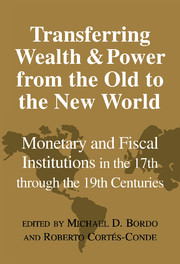 Transferring Wealth and Power from the Old to the New World
Transferring Wealth and Power from the Old to the New World Published online by Cambridge University Press: 27 March 2010
In 1776, on publishing his famous work, The Wealth of Nations, Adam Smith was convinced that the fiscal structure of the Spanish Empire in Central and South America was more efficient than that of the crumbling British colonial administration in North America. A quarter of a century later, in 1803, on his prolonged visit to Mexico, Alexander von Humboldt obtained a similar impression, which he registered in his widely read Political Essay on the Kingdom of New Spain, underlining the fact that the Mexican fiscal system was an extraordinarily successful tax machine. On the other hand, by the midnineteenth century, both domestic and foreign observers expressed a gloomy and pessimistic view of the finances of the independent Mexican republic, a fact ratified by its incapacity to defend its territory adequately against foreign invasion forces, whether from the United States or from Europe.
These contrasting historical views are testimony to a singular and still unexplained transition of Mexico from rich colony to poor nation, at least from the point of view of state finance. This striking shift is particularly surprising given the fact that Mexico was the largest silver producer and exporter in the world in the late eighteenth century. The Mexican silver peso circulated everywhere – throughout the islands of the Caribbean, in Europe (generally being reminted or restamped), and as far away as China and India, where it had been used for centuries.
To save this book to your Kindle, first ensure [email protected] is added to your Approved Personal Document E-mail List under your Personal Document Settings on the Manage Your Content and Devices page of your Amazon account. Then enter the ‘name’ part of your Kindle email address below. Find out more about saving to your Kindle.
Note you can select to save to either the @free.kindle.com or @kindle.com variations. ‘@free.kindle.com’ emails are free but can only be saved to your device when it is connected to wi-fi. ‘@kindle.com’ emails can be delivered even when you are not connected to wi-fi, but note that service fees apply.
Find out more about the Kindle Personal Document Service.
To save content items to your account, please confirm that you agree to abide by our usage policies. If this is the first time you use this feature, you will be asked to authorise Cambridge Core to connect with your account. Find out more about saving content to Dropbox.
To save content items to your account, please confirm that you agree to abide by our usage policies. If this is the first time you use this feature, you will be asked to authorise Cambridge Core to connect with your account. Find out more about saving content to Google Drive.